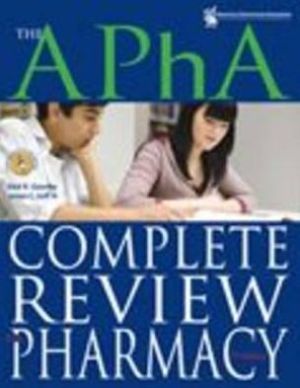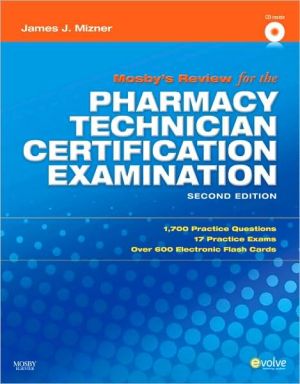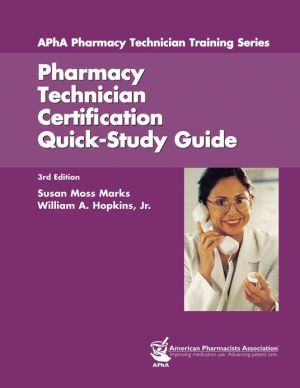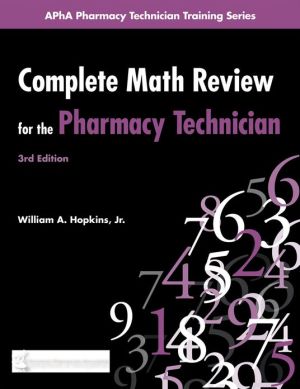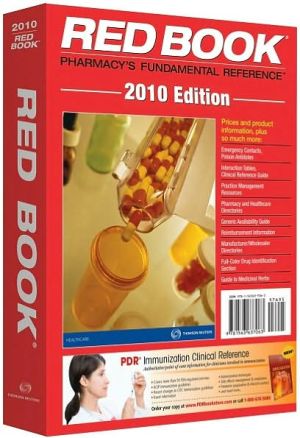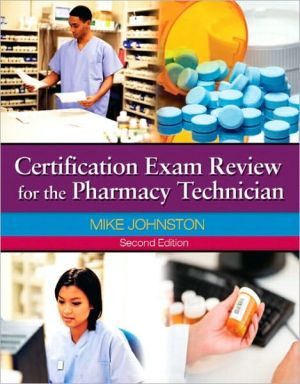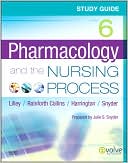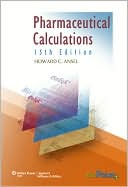APhA Complete Review for Pharmacy
The NAPLEX® (North American Pharmacist Licensure\ Examination®) is the standard licensing exam that all U.S.\ pharmacy students must pass to practice pharmacy. It's an\ arduous exam that tests a daunting range of knowledge.\ Approximately 10% of students taking the exam for the\ fi rst time fail to achieve a passing score. Preparing for\ the NAPLEX® by reviewing all the material from each\ pharmacy school course would be overwhelming. A far\ better approach would be to study only the...
Search in google:
The NAPLEX® (North American Pharmacist LicensureExamination®) is the standard licensing exam that all U.S.pharmacy students must pass to practice pharmacy. It's anarduous exam that tests a daunting range of knowledge.Approximately 10% of students taking the exam for thefi rst time fail to achieve a passing score. Preparing forthe NAPLEX® by reviewing all the material from eachpharmacy school course would be overwhelming. A farbetter approach would be to study only the informationmost relevant to the exam, summarized in abbreviatedbullet format, and that's what The APhA Complete Reviewfor Pharmacy contains.All chapters of the book were updated. A current, one volumecompilation of pharmacy knowledge, The APhAComplete Review for Pharmacy is also a popular referencefor busy practitioners wishing to stay current.Key Features: Top 200 drugs. The place to begin NAPLEX®preparation: learning the generic and trade names forthe top 200 drugs (Appendices). Math. After drug names, pharmacy math is the mostimportant single area to review (Chapter 1). Drug therapy for chronic and common diseases. This isthe heart of today's NAPLEX® and the subject of morethan half this study guide's 37 chapters. Review questions. All chapters end with 20 ormore practice exam questions and answers, plusexplanations that reinforce key learning points. Test questions on CD-ROM. The enclosed CD-ROMgives users 3 options: Learning Mode, whichallows users to customize the test-taking experience;Certifi cation Mode, which delivers the test as it wasauthored; and FlashcardMode. Seasoned advice on studying for and taking theNAPLEX® from James C. Eoff III, who has coordinatedthe board review course at the University of TennesseeCollege of Pharmacy for more than 30 years. Doody Review Services Reviewer:Christopher Widdick, PharmD Student(Temple University School of Pharmacy)Description:For students about to take the boards, or healthcare professionals who want to brush up, this is a comprehensive collection of data on disease states and the therapy used to treat them. It also covers topics such as pharmacokinetics, pharmacy law, and pharmaceutical calculations.Purpose:The main purpose is to provide a condensed, all-inclusive review of pharmacy, which the book does very well. Readers do not lose the big picture in a lot of small detail.Audience:Since the intent of the book is to reinforce just the principal information, readers without previous training may need further information to fully understand topics. The review is a publication of the American Pharmacists Association (APhA). Features:The book's user-friendly layout segregates each topic into sections then outlines the background information before proceeding to the core drug knowledge. In an effort to reinforce readers' confidence, each section contains a summary test at the end. The answers, provided directly after the section, include reasoning for the correct conclusion and choice. As a pharmacy student, I have found it difficult to digest the information crammed into the short semesters. The topics in this book are in sequential order and include some I haven't seen in at least two semesters. Assessment:Overall, I found this book a great way to refresh my memory of pharmacy topics covered earlier in the curriculum. Because I wasn't seeing these topics for the first time and getting slammed with test after test, I was able to retain the information, which was presented in a beautiful format. The table of contents precisely lays out the areas covered. The only shortcoming is the lack of images, although the book does contain tables of information. However, since the majority of the book is straight text, it may not be the best choice for visual learners.
\ From The CriticsReviewer: Christopher Widdick, PharmD Student(Temple University School of Pharmacy)\ Description: For students about to take the boards, or healthcare professionals who want to brush up, this is a comprehensive collection of data on disease states and the therapy used to treat them. It also covers topics such as pharmacokinetics, pharmacy law, and pharmaceutical calculations.\ Purpose: The main purpose is to provide a condensed, all-inclusive review of pharmacy, which the book does very well. Readers do not lose the big picture in a lot of small detail.\ Audience: Since the intent of the book is to reinforce just the principal information, readers without previous training may need further information to fully understand topics. The review is a publication of the American Pharmacists Association (APhA). \ Features: The book's user-friendly layout segregates each topic into sections then outlines the background information before proceeding to the core drug knowledge. In an effort to reinforce readers' confidence, each section contains a summary test at the end. The answers, provided directly after the section, include reasoning for the correct conclusion and choice. As a pharmacy student, I have found it difficult to digest the information crammed into the short semesters. The topics in this book are in sequential order and include some I haven't seen in at least two semesters. \ Assessment: Overall, I found this book a great way to refresh my memory of pharmacy topics covered earlier in the curriculum. Because I wasn't seeing these topics for the first time and getting slammed with test after test, I was able to retain the information, which was presented in a beautiful format. The table of contents precisely lays out the areas covered. The only shortcoming is the lack of images, although the book does contain tables of information. However, since the majority of the book is straight text, it may not be the best choice for visual learners.\ \ \ \ \ From The CriticsReviewer:Christopher Widdick, PharmD Student(Temple University School of Pharmacy)\ Description:For students about to take the boards, or healthcare professionals who want to brush up, this is a comprehensive collection of data on disease states and the therapy used to treat them. It also covers topics such as pharmacokinetics, pharmacy law, and pharmaceutical calculations.\ Purpose:The main purpose is to provide a condensed, all-inclusive review of pharmacy, which the book does very well. Readers do not lose the big picture in a lot of small detail.\ Audience:Since the intent of the book is to reinforce just the principal information, readers without previous training may need further information to fully understand topics. The review is a publication of the American Pharmacists Association (APhA). \ Features:The book's user-friendly layout segregates each topic into sections then outlines the background information before proceeding to the core drug knowledge. In an effort to reinforce readers' confidence, each section contains a summary test at the end. The answers, provided directly after the section, include reasoning for the correct conclusion and choice. As a pharmacy student, I have found it difficult to digest the information crammed into the short semesters. The topics in this book are in sequential order and include some I haven't seen in at least two semesters. \ Assessment:Overall, I found this book a great way to refresh my memory of pharmacy topics covered earlier in the curriculum. Because I wasn't seeing these topics for the first time and getting slammed with test after test, I was able to retain the information, which was presented in a beautiful format. The table of contents precisely lays out the areas covered. The only shortcoming is the lack of images, although the book does contain tables of information. However, since the majority of the book is straight text, it may not be the best choice for visual learners.\ \ \ From The CriticsReviewer: Christopher Widdick, PharmD Student(Temple University School of Pharmacy)\ Description: For students about to take the boards, or healthcare professionals who want to brush up, this is a comprehensive collection of data on disease states and the therapy used to treat them. It also covers topics such as pharmacokinetics, pharmacy law, and pharmaceutical calculations.\ Purpose: The main purpose is to provide a condensed, all-inclusive review of pharmacy, which the book does very well. Readers do not lose the big picture in a lot of small detail.\ Audience: Since the intent of the book is to reinforce just the principal information, readers without previous training may need further information to fully understand topics. The review is a publication of the American Pharmacists Association (APhA).\ Features: The book's user-friendly layout segregates each topic into sections then outlines the background information before proceeding to the core drug knowledge. In an effort to reinforce readers' confidence, each section contains a summary test at the end. The answers, provided directly after the section, include reasoning for the correct conclusion and choice. As a pharmacy student, I have found it difficult to digest the information crammed into the short semesters. The topics in this book are in sequential order and include some I haven't seen in at least two semesters.\ Assessment: Overall, I found this book a great way to refresh my memory of pharmacy topics covered earlier in the curriculum. Because I wasn't seeing these topics for the first time and getting slammed with test after test, I was able to retain the information, which was presented in a beautiful format. The table of contents precisely lays out the areas covered. The only shortcoming is the lack of images, although the book does contain tables of information. However, since the majority of the book is straight text, it may not be the best choice for visual learners.\ \
